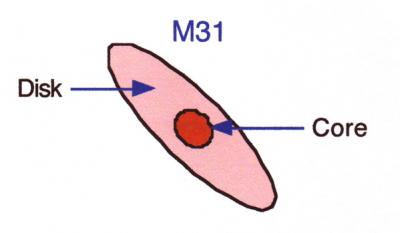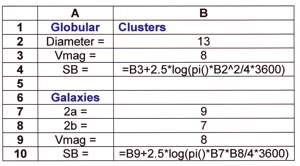"Bright" Ideas
Submitted: Friday, 3rd July 2009 by Rob Horvat
How bright is “bright”?When we say an object is “bright”, we are comparing it to something else. It is implied that it is brighter than a lot of other objects in a group or is, perhaps, the brightest object in the group. In different contexts, we could use the word “bright” to describe the Sun, the Moon, Venus, Sirius, the globular cluster Omega Centauri and the Andromeda Galaxy. How bright an object appears visually can be very different to how bright it appears in a photographic image. Faint objects can appear quite bright using long and/or multiple exposures. Various measures have been devised in an attempt to quantify brightness. With regard to stars, we can measure brightness as an absolute magnitude or an apparent magnitude. Absolute magnitude measures how bright each star would appear at a fixed distance of 10 parsecs (32.6 light years). Standardising the distance means that variations between the brightness of stars will depend solely on each star’s luminosity (energy output per unit time). So, absolute magnitude is a measure of the inherent luminosity or power of the star. Apparent Magnitude (Visual Magnitude or Vmag for short)How bright a star appears visually depends on its luminosity and its distance from the Earth. For a given luminosity, the further away the star, the dimmer it will appear. The Greek astronomer Hipparchus (about 120 BC) devised a simple way to classify stars according to their brightness. He divided stars into 6 classes based on their apparent or visual brightness. The 20 brightest stars were assigned a value of 1 and stars just visible to the naked eye a value of 6. We still use a similar system today but it has been formalized more mathematically … Now, 6-1 = 5 and 1001/5 ~= 2.512. The number 2.512 is known as Pogson’s Ratio. Therefore, a star of magnitude 1 is 2.512 times brighter than a star of magnitude 2, a star of magnitude 2 is 2.512 times brighter than a star of magnitude 3, and so on. The higher the numeric value of the apparent or visual magnitude (Vmag), the fainter the star will appear to the observer. For night-sky objects, the intensity of the electromagnetic radiation received will depend on the wavelength being measured. In the UBV system, the intensity can be measured in the Ultraviolet, Blue or Visual regions. The V band is used for stars as this gives magnitudes which are more in tune with the human eye. Measured Vmags for stars correspond pretty well with what we see, as stars (excluding our Sun) are so far away they are just seen as small points of light. Depending on the brightness of the star and the optics of your telescope, a star will appear as a small circle of light around 1 arcsecond in diameter (one arcminute or 1’ is 1/60th of a degree and one arcsecond or 1” is 1/60th of an arcminute). However, quoted Vmags for larger objects, such as galaxies, may have been partially measured or simply just estimated by an observer. In any case, there is a large amount of variability between different sources for the Vmags of larger objects. Quite often, for other reasons, the Vmag doesn’t seem to match the observed brightness of the object seen in our telescopes . . . Surface BrightnessFor larger objects such as star clusters and galaxies, the Vmag is a measure of the overall apparent brightness of the object as if it were a small point of light like a star. Equivalent to matching the total brightness of the object to a star of similar brightness. Visual magnitude makes no allowance for the apparent size of the object being looked at. For example, the star Rasalgethi (alpha Herculis) and the large Beehive Cluster in Cancer both have Vmag 3.1. Surface brightness (SB) is another way to measure the brightness of an object. Astronomers measure surface brightness in magnitudes per square arcsecond or magnitudes per square arcminute (note: mags per sq arcsec ~= mags per sq arcmin + 8.9). A SB of 20 mags per sq arcsec is also equivalent to 20 – 8.9 = 11.1 mags per sq arcmin. As one sq arcmin = 3600 sq arcsec then each square arcminute would fit 3600 stars, each of magnitude 20. Because a square arcminute is much larger than the size of a star, it is not as intuitive a measure.
SB for globular clusters and galaxies mostly vary upwards from 20 magnitudes per sq arcsec. Of course, the observed brightness of an object will depend not only on the size of aperture but also on external factors such as the amount of skyglow and the transparency of the atmosphere. Globular ClustersThe apparent size of a globular cluster is usually given as a diameter (d) in minutes of arc. This table allows you to calculate the SB of a globular cluster from its diameter d minutes and its Vmag m:
SB = m + Correction (due to surface area) Examples:
GalaxiesSpiral and elliptical galaxies are mostly seen as ellipses (some are irregular). The ellipse will have long axis 2a and short axis 2b. The apparent dimensions of a galaxy are given as 2a x 2b in minutes
If the value of a is nearer to b, the galaxy is seen more face on: e.g. M83 in Hydra, 13’ x 11.5’.
The surface brightness of a galaxy will depend on both its Vmag and its dimensions. For example, M33 in Triangulum has Vmag 5.7 and M66 in Leo has Vmag 9. Just from the visual magnitudes, you would expect M33 to be much brighter. However, M33 is large visually (70’ x 40’). It has SB 22.9 and is quite dim. M66 is much smaller visually (9’ x 4’). It has SB 21.5 and is fairly bright. Visually, M66 is noticeable brighter than M33. The surface brightness is a better indicator of the observed brightness.
This table allows you to calculate the approximate surface brightness of a galaxy from its dimensions 2a x 2b in arcminutes and its Vmag m. Choose the dimensions closest to those given for the galaxy. Galaxies with a large apparent size (e.g. M31) are covered in the next section.
SB = m + Correction (due to surface area) Examples:
Some Popular Objects Distributed According to Vmag and SBThese tables illustrate the deficiency in using Vmag alone as an indicator of observed brightness.
These Local Galaxies were not included in the table above:
|
 |
The value of the core’s SB is probably less than 20 (very bright). The overall SB using the galaxy dimensions 3 by 1 degrees is about 22.1. If the larger dimensions 5 by 1.5 degrees were used the SB would be drop to 23.1. The size and lower brightness of the surrounding disk results in a significantly fainter SB value.
For M31, neither the Vmag nor the SB indicate how well we can observe the overall structure.
This is particularly noticeable under light pollution where only the bright core is likely to be seen.
To calculate SB automatically, type the following entries into an Excel Workbook (spreadsheet):
 |
Click to Enlarge Table 6 |
In my spreadsheet, I’ve set the cell Format for B4 and B10 to Number with 1 decimal place.
If you’ve done it correctly, cells B4 and B10 should read 22.2 and 21.1.
The default values for B2, B3, B7, B8, B9 are just arbitrary. Replace these values with the dimensions of the object you wish to calculate the SB for. The SB is measured in magnitudes per square arcsecond.
If you want the SB in magnitudes per square arcminute, remove *3600 from the cells B4 and B10.
{Note: * is used for “multiplied by”, ^ is used for “to the power of”, pi() is p or 3.1415926 . . . and the area of an ellipse = pab = p x 2a x 2b /4}
If you have an Excel list of galaxies with Vmag and dimensions 2a x 2b in minutes, you can introduce another column to calculate SB. You will need to have the dimensions in two separate columns headed 2a and 2b.
Example: the first galaxy of a list is shown-
 |
Click to Enlarge Table 7 |
The formula entry for cell F3 is =C3+2.5*log(pi()*D3*E3/4*3600)
If you have other columns in your list (e.g. Type of Galaxy), which force you to enter this formula into column G or H or …, you will have to adjust the cell references in the formula.
Do a Fill Down to copy the formula for each galaxy in your list.
You can then sort the galaxies according to SB.
Save this as a separate Excel workbook if you still want your original galaxy list intact.
Final note: the calculated SB will only be as accurate as the sourced Vmag and dimensions.
The Vmag for an object can vary considerably from different sources. Sometimes B (Blue) magnitude is mistakenly used for Vmag. I find it somewhat amusing but also frustrating that the visual magnitude for an object can be given to one decimal place when variations of 0.5 (and more) can occur between “reliable” sources!
The visual magnitudes and dimensions used in this article were sourced mainly from SIMBAD, NED, the Revised NGC Catalog (access through NED) or SEDS e.g. SEDS NGC 253 as Google search.
Article by Rob Horvat (Robh). Discuss this Article at the IceInSpace Forum.